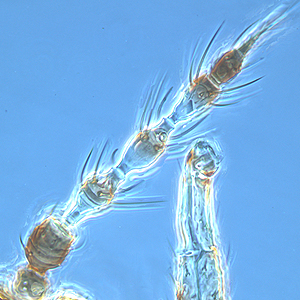Figures
Fig. 1: Antenna
Fig. 2: Head dorsal with ocellar triangle
Fig. 3: Pronotum
Fig. 4: Meso- and metanotum
Fig. 5: Fore- and hindwing
Fig. 6: Meso- and metasternum
Fig. 7: Tergites V and VI
Fig. 8: Tergites VIII-X
Taxonomic Information
Species:
Caliothrips phaseoli (Hood, 1912)
Synonyms:
Caliothrips flavescentis De Santis, 1967
Hercothrips ipomoeae Moulton, 1932
Heliothrips braziliensis Morgan, 1929
Heliothrips gossypii Moulton, 1927
Heliothrips fasciatus Pergande, 1920
Heliothrips phaseoli Hood, 1912
Common name:
None established
Present taxonomic position:
Family: Thripidae Stephens, 1829
Subfamily: Panchaetothripinae Bagnall, 1912
Genus: Caliothrips Daniel, 1904
Species Recognition
General information about the genus Caliothrips:Members of this genus are dark brown, contain heavy net-like sculpture with internal markings, have banded wings and 8 antennal segments. Most of the species in this group are found living in grasses and legumes.
Typical character states of Caliothrips phaseoli:
Body color
Mainly brown
Antennae
Number of antennal segments: 8
Segment IV - forked sensorium: extending to a point at least 30% distal to base of segment V
Segments III & IV sensoria: emergent and forked
Terminal antennal segments: very long, needle like
Head:
Head shape between compound eyes: not prolonged
Sculptured reticles on head and pronotum: with internal sculptured markings
Surface of head, pronotum and fore legs: with strong reticulate sculpture, but sometimes irregular
Head posteriorly: not constricted
Prothorax
Number of pairs of elongate pronotal setae: 0-3
Number of pairs of elongate posteroangular pronotal setae: 0
Sculptur of pronotum: without transverse striate sculpture
Mesothorax
Mesothoracic endofurca: without median spinula
Metathorax
Metanotum: with campaniform sensilla
Metanotum median area: with at least some equiangular reticulation
Metanotum sculpture: without dominant sculptured triangle medially
Metathoracic endofurca: elongate and lyre-shape
Wings
Wings: present and more than half as long as abdomen
First vein of forewing: close to or fused to costal vein
Forewing anterior margin: with setae and cilia but setae longer than cilia
Forewing color: alternating bands of dark and light
Forewing costal setae at middle of wing: longer than median width of wing
Forewing first vein setal row: incomplete, with setae not closely and uniformly spaced
Forewing posterior margin cilia: undulated near apex
Forewing second vein setal row: complete, with setae closely and uniformly spaced
Forewing surface: not reticulate
Forewings: with veins, setae and microtrichia
Legs
Mid and hind tarsi: with one segment
Abdomen:
Abdominal segment X: never tubular, longitudinally incomplete ventrally in both sexes
Abdominal tergites: without curved wing-retaining setae
Abdominal tergites IV & V median setal pair: much shorter than distance between their bases
Setae on abdominal tergite X: slender
Tergite VIII posteromarginal comb of microtrichia: present laterally, incomplete medially
Tergites III to VI sculpture on lateral thirds: comprising mainly transverse parallel lines
Biology
Life history:
Probably similar to the longevity of
Caliothrips fasciatus larvae ranging from 0-14 days and adults ranging from
7-15 days both dependent on temperature (Lewis 1973).
Host plants:
Beans, cotton, soybean, sunflower
Vector capacity:
None identified
Current known distribution:
Central and South America, North America
Additional notes:
Caliothrips braziliensis is
similar in form to C.
phaseoli species and is found in Central America through Ecuador and
Argentina.
Bibliography
Lewis, T (1973): Thrips.
Their Biology, Ecology and Economic Importance. Academic Press, New York,
xvi, 350 ppg.
Mazza, CA, Izaguirre, MM, Zavala, J, Scopel, AL & Ballare,
CL (2002): Insect perception of ambient ultraviolet-B radiation. - Ecology
Letters 5 (6): 722-726.
Mazza, CA, Zavala, J, Scopel, AL & Ballare,
CL (1999): Perception of solar UVB radiation by phytophagous insects:
Behavioral responses and ecosystem implications. - Proceedings of the
National Academy of Sciences of the United States of America 96 (3):
980-985.
Moritz G, Morris DC, Mound LA (2001): ThripsID - Pest thrips of the world. ACIAR and CSIRO Publishing Collingwood, Victoria, Australia, CDROM ISBN 1 86320 296 X.
Moritz G, Mound LA, Morris DC, Goldarazena A (2004): Pest thrips of the world - an identification and information system using molecular and microscopial methods. CBIT, University of Queensland,CDROM ISBN 1-86499-781-8.
Mound, LA & Marullo, R (1996): The thrips of Central
and South America: An Introduction (Insecta: Thysanoptera). Associated
Publishers, Gainesville.
Mound, LA & Kibby, G (1998): Thysanoptera: An identification
guide, (2nd edition). CAB International, Wallingford and New York, 70pp.
Palmer, JM, Mound, LA & Du Heaume GJ (1989): 2.
Thysanoptera, pp. 73. In Betts, CR [ed.], CIE Guides
to Insects of Important to Man. CAB International, Wallingford.
Links:
Mound, LA (2005): Thysanoptera (Thrips) of the World
- A Checklist. http://www.ento.csiro.au/thysanoptera/worldthrips.html









